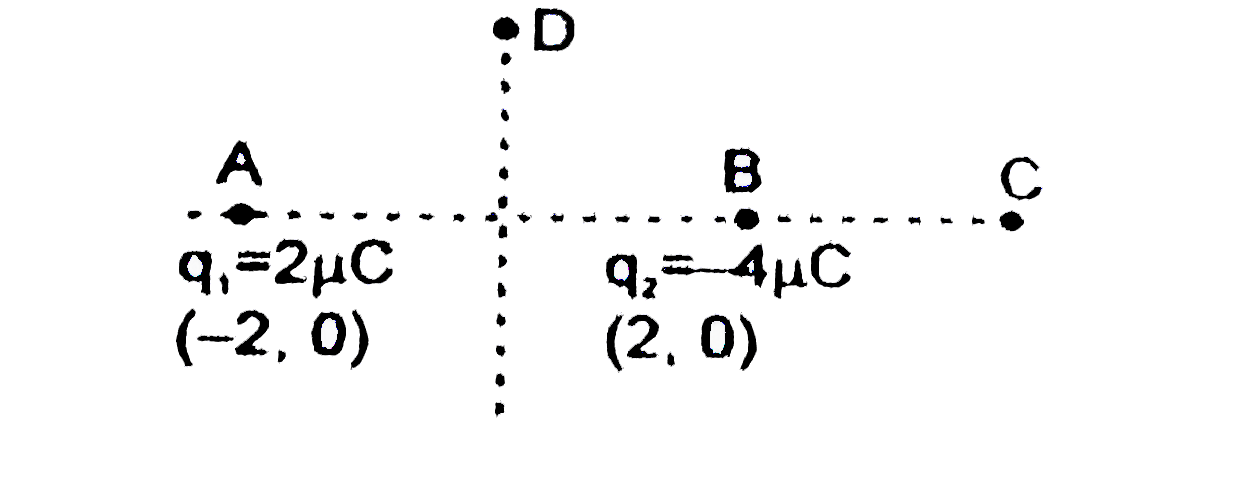Consider a spherical surface of radius 4 m cenred at the origin. Point charges +q and - 2q are fixed at points A( 2 m, 0,0) and B( 8 m, 0, 0), respectively. Show that every point on the shperical surface is at zero potential.
To show that every point on the spherical surface of radius 4 m centered at the origin is at zero potential due to the point charges +q and -2q located at A(2 m, 0, 0) and B(8 m, 0, 0) respectively, we can follow these steps:
Step 1: Understand the Configuration
We have:
- A spherical surface of radius R=4 m centered at the origin (0, 0, 0).
- A positive point charge +q located at point A(2 m, 0, 0).
- A negative point charge −2q located at point B(8 m, 0, 0).
Step 2: Identify Points on the Spherical Surface
Let’s consider any point P on the spherical surface. The distance from the origin to any point on the surface is R=4 m.
Step 3: Calculate the Potential at Point P
The electric potential V at point P due to a point charge is given by the formula:
V=kQr
where k is Coulomb's constant, Q is the charge, and r is the distance from the charge to the point where we are calculating the potential.
Step 4: Calculate the Distance from Charges to Point P
1. Distance from charge +q at A(2 m, 0, 0):
- The distance from the charge +q to point P is r1=|OP−OA|=|4−2|=2 m.
2. Distance from charge −2q at B(8 m, 0, 0):
- The distance from the charge −2q to point P is r2=|OP−OB|=|4+4|=8 m.
Step 5: Calculate the Potential at Point P
Now, we can calculate the total potential VP at point P:
VP=V+q+V−2q
Substituting the distances:
VP=kqr1+k−2qr2
VP=kq2+k−2q8
VP=kq2−kq4
VP=k(q2−q4)=k(2q4−q4)=kq4
Step 6: Simplify the Expression
Since both terms have the same factor k and q:
VP=kq4−kq4=0
Conclusion
Thus, the potential at any point P on the spherical surface is zero. This holds true for all points on the surface due to the symmetry of the charge distribution.
We have:
- A spherical surface of radius R=4 m centered at the origin (0, 0, 0).
- A positive point charge +q located at point A(2 m, 0, 0).
- A negative point charge −2q located at point B(8 m, 0, 0).
Let’s consider any point P on the spherical surface. The distance from the origin to any point on the surface is R=4 m.
The electric potential V at point P due to a point charge is given by the formula:
V=kQr
where k is Coulomb's constant, Q is the charge, and r is the distance from the charge to the point where we are calculating the potential.
1. Distance from charge +q at A(2 m, 0, 0):
- The distance from the charge +q to point P is r1=|OP−OA|=|4−2|=2 m.
- The distance from the charge −2q to point P is r2=|OP−OB|=|4+4|=8 m.
Now, we can calculate the total potential VP at point P:
VP=V+q+V−2q
Substituting the distances:
VP=kqr1+k−2qr2
VP=kq2+k−2q8
VP=kq2−kq4
VP=k(q2−q4)=k(2q4−q4)=kq4
Since both terms have the same factor k and q:
VP=kq4−kq4=0
Thus, the potential at any point P on the spherical surface is zero. This holds true for all points on the surface due to the symmetry of the charge distribution.
Topper's Solved these Questions
- BOOK - CENGAGE PHYSICS ENGLISHCHAPTER - ELECTRIC POTENTIALEXERCISE - Examples9videos
ELECTRIC POTENTIAL
- BOOK - CENGAGE PHYSICS ENGLISHCHAPTER - ELECTRIC POTENTIALEXERCISE - Exercise 3.123videos
ELECTRIC POTENTIAL
- BOOK - CENGAGE PHYSICS ENGLISHCHAPTER - ELECTRIC FLUX AND GAUSS LAWEXERCISE - MCQ s38videos
ELECTRIC FLUX AND GAUSS LAW
- BOOK - CENGAGE PHYSICS ENGLISHCHAPTER - ELECTRICAL MEASURING INSTRUMENTSEXERCISE - M.C.Q2videos
ELECTRICAL MEASURING INSTRUMENTS
Similar Questions
Two point charges +q and -q are held fixed at (−a,0) and (a,0) respectively of a x-y coordinate system then
View SolutionTwo point charges q and –q are at positions (0,0,d) and (0,0, –d) respectively . What is the electric field at (a,0,0 ) ?
View SolutionTwo point charges q and –q are at positions (0,0,d) and (0,0, –d) respectively . What is the electric field at (a,0,0 ) ?
View SolutionTwo point charges of magnitude +qand−q are placed at (−d/2,0,0)and(d/2,0,0) are respectively. Find the equation of the euipotential surface where the potential is zero.
View SolutionTwo point charges −q and +q are located at points (0,0−a) and (0,0,a) respectively. The electric potential at point (0,0,z)is (Z>a)
View SolutionPoint charges +4q,−q and +4q are kept on the x-axis at points x=0,x=a and x=2a respectively, then
View SolutionTwo charges q1andq2 are placed at (0,0,d) and (0,0,-d) respectively. Find locus of points where the potential is zero.
View Solutiontwo point charges 2μC and −4μC are situated at points (−2m,0m) and (2m,0m) respectively. Find out potential at point C(4m,0m) and D(0m,√5m).
 View Solution
View Solution(i) Can two equpotential surfaces intersect each other ? Give reason.
(ii) Two charges +qand−q are located at points A (0,0,−2)andB(0,0,2) respectively. How much work will be done in moving a test charge from point P(4,0,0) to (−5,0,0) ?View SolutionTwo point charge −q and +q/2 are situated at the origin and the point (a,0,0) respectively. The point along the X-axis where the electic field Vanishes is
View Solution

